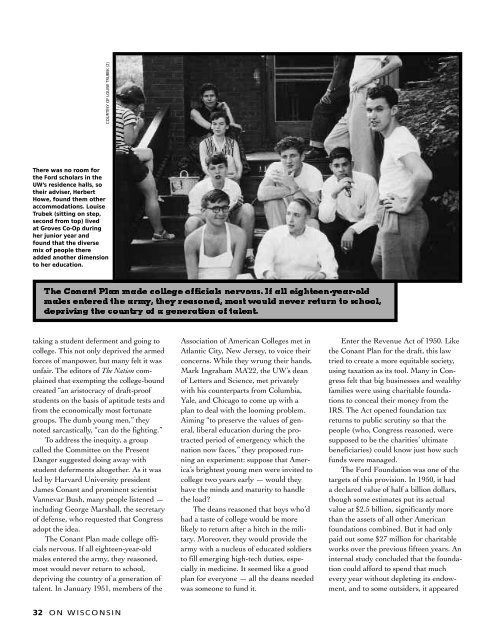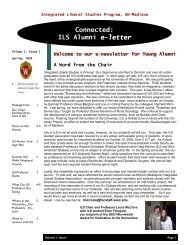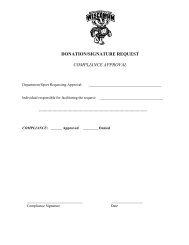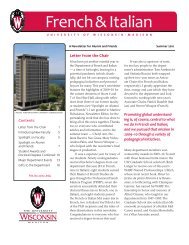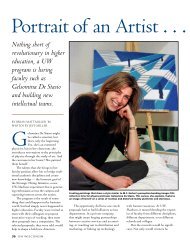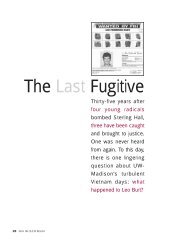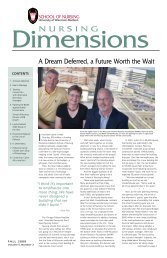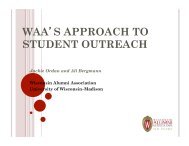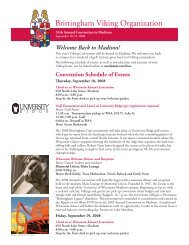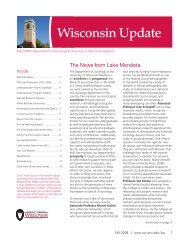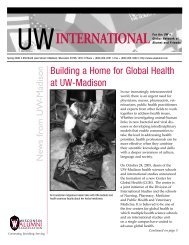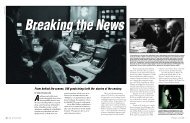The Ford Boys (pdf) - Wisconsin Alumni Association
The Ford Boys (pdf) - Wisconsin Alumni Association
The Ford Boys (pdf) - Wisconsin Alumni Association
- No tags were found...
Create successful ePaper yourself
Turn your PDF publications into a flip-book with our unique Google optimized e-Paper software.
COURTESY OF LOUISE TRUBEK (2)<br />
<strong>The</strong>re was no room for<br />
the <strong>Ford</strong> scholars in the<br />
UW’s residence halls, so<br />
their adviser, Herbert<br />
Howe, found them other<br />
accommodations. Louise<br />
Trubek (sitting on step,<br />
second from top) lived<br />
at Groves Co-Op during<br />
her junior year and<br />
found that the diverse<br />
mix of people there<br />
added another dimension<br />
to her education.<br />
<strong>The</strong> Conant Plan made college officials nervous. If all eighteen-year-old<br />
males entered the army, they reasoned, most would never return to school,<br />
depriving the country of a generation of talent.<br />
taking a student deferment and going to<br />
college. This not only deprived the armed<br />
forces of manpower, but many felt it was<br />
unfair. <strong>The</strong> editors of <strong>The</strong> Nation complained<br />
that exempting the college-bound<br />
created “an aristocracy of draft-proof<br />
students on the basis of aptitude tests and<br />
from the economically most fortunate<br />
groups. <strong>The</strong> dumb young men,” they<br />
noted sarcastically, “can do the fighting.”<br />
To address the inequity, a group<br />
called the Committee on the Present<br />
Danger suggested doing away with<br />
student deferments altogether. As it was<br />
led by Harvard University president<br />
James Conant and prominent scientist<br />
Vannevar Bush, many people listened —<br />
including George Marshall, the secretary<br />
of defense, who requested that Congress<br />
adopt the idea.<br />
<strong>The</strong> Conant Plan made college officials<br />
nervous. If all eighteen-year-old<br />
males entered the army, they reasoned,<br />
most would never return to school,<br />
depriving the country of a generation of<br />
talent. In January 1951, members of the<br />
<strong>Association</strong> of American Colleges met in<br />
Atlantic City, New Jersey, to voice their<br />
concerns. While they wrung their hands,<br />
Mark Ingraham MA’22, the UW’s dean<br />
of Letters and Science, met privately<br />
with his counterparts from Columbia,<br />
Yale, and Chicago to come up with a<br />
plan to deal with the looming problem.<br />
Aiming “to preserve the values of general,<br />
liberal education during the protracted<br />
period of emergency which the<br />
nation now faces,” they proposed running<br />
an experiment: suppose that America’s<br />
brightest young men were invited to<br />
college two years early — would they<br />
have the minds and maturity to handle<br />
the load<br />
<strong>The</strong> deans reasoned that boys who’d<br />
had a taste of college would be more<br />
likely to return after a hitch in the military.<br />
Moreover, they would provide the<br />
army with a nucleus of educated soldiers<br />
to fill emerging high-tech duties, especially<br />
in medicine. It seemed like a good<br />
plan for everyone — all the deans needed<br />
was someone to fund it.<br />
Enter the Revenue Act of 1950. Like<br />
the Conant Plan for the draft, this law<br />
tried to create a more equitable society,<br />
using taxation as its tool. Many in Congress<br />
felt that big businesses and wealthy<br />
families were using charitable foundations<br />
to conceal their money from the<br />
IRS. <strong>The</strong> Act opened foundation tax<br />
returns to public scrutiny so that the<br />
people (who, Congress reasoned, were<br />
supposed to be the charities’ ultimate<br />
beneficiaries) could know just how such<br />
funds were managed.<br />
<strong>The</strong> <strong>Ford</strong> Foundation was one of the<br />
targets of this provision. In 1950, it had<br />
a declared value of half a billion dollars,<br />
though some estimates put its actual<br />
value at $2.5 billion, significantly more<br />
than the assets of all other American<br />
foundations combined. But it had only<br />
paid out some $27 million for charitable<br />
works over the previous fifteen years. An<br />
internal study concluded that the foundation<br />
could afford to spend that much<br />
every year without depleting its endowment,<br />
and to some outsiders, it appeared<br />
32 ON WISCONSIN


